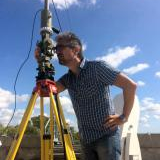Applications of UAVs in Civil Infrastructure
A special issue of Drones (ISSN 2504-446X).
Deadline for manuscript submissions: 15 September 2024 | Viewed by 13985
Special Issue Editors
Interests: structural engineering; bridge design and assessment; structural dynamics; structural health monitoring; image-based condition assessment; drones
Interests: drones; GPS/GNSS; geomatic; geodesy; photogrammetry; survey; remote sensing; GIS; post seismic survey
Special Issues, Collections and Topics in MDPI journals
Special Issue Information
Dear Colleagues,
Drones have proven to have significant potential in supporting the condition assessment of civil infrastructure and contribute to more efficient maintenance procedures. Unmanned Aerial Vehicles (UAVs) can function as flexible platforms for carrying high-quality digital data acquisition equipment such as image sensors of different spectral ranges, lidar scanners, and GPR as well as further surveying and non-destructive testing devices. They can be operated semi or fully autonomously and thus perform extensive data generation operations near large structures very efficiently. The processing of acquired sensor data can support digital modeling of existing structures, provide deep insight into the structure’s condition and through repeated and systematic flights pave the way to modern data-driven and predictive maintenance strategies. Furthermore, drones can be applied in the context of infrastructure planning for early site investigations or construction progress monitoring. Finally, drones have proven to be very efficient in the management of seismic events and other natural disasters both for early damage assessment and for the safe survey of damaged buildings in order to plan the recovery or restoration of damaged historical buildings.
The enormous potential of UAVs in civil infrastructure requires further scientific developments and the implementation and validation of suitable workflows for ensuring safe, goal-oriented, quality-controlled, and optimized flight operations and data analysis. This Special Issue is aimed at showcasing contributions to the application of UAVs in relation to civil infrastructure on the methodological level as well as on successful and novel applications.
Suggested topics for article contributions are:
- UAV and sensor hardware development and optimization for applications in civil infrastructure;
- Automatic and autonomous UAV operation and flight planning near infrastructures;
- Application scenarios and novel strategies for UAV operation, data generation and analysis for infrastructure planning, construction and maintenance;
- Complex use cases, validation, benchmark data and quality assessment of UAV applications;
- Analysis methods and workflows for UAV data in the context of surveying, 3D modeling, condition assessment, visualization and asset management;
- Methods and procedures for the safe survey of buildings and structures after seismic events and other natural disasters;
- Proposals for criteria, regulations and standards for UAV applications in civil infrastructure.
Prof. Dr. Guido Morgenthal
Prof. Dr. Valerio Baiocchi
Guest Editors
Manuscript Submission Information
Manuscripts should be submitted online at www.mdpi.com by registering and logging in to this website. Once you are registered, click here to go to the submission form. Manuscripts can be submitted until the deadline. All submissions that pass pre-check are peer-reviewed. Accepted papers will be published continuously in the journal (as soon as accepted) and will be listed together on the special issue website. Research articles, review articles as well as short communications are invited. For planned papers, a title and short abstract (about 100 words) can be sent to the Editorial Office for announcement on this website.
Submitted manuscripts should not have been published previously, nor be under consideration for publication elsewhere (except conference proceedings papers). All manuscripts are thoroughly refereed through a single-blind peer-review process. A guide for authors and other relevant information for submission of manuscripts is available on the Instructions for Authors page. Drones is an international peer-reviewed open access monthly journal published by MDPI.
Please visit the Instructions for Authors page before submitting a manuscript. The Article Processing Charge (APC) for publication in this open access journal is 2600 CHF (Swiss Francs). Submitted papers should be well formatted and use good English. Authors may use MDPI's English editing service prior to publication or during author revisions.
Keywords
- Unmanned Aerial Vehicles
- civil infrastructure
- condition assessment
- surveying
- image analysis
- monitoring
- 3D modeling
- flight control
- natural disaster response






